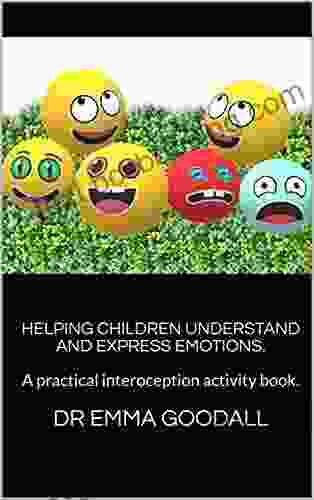Empowering Little Hearts: Helping Children Understand and Express Emotions

Our children are the cornerstone of our world, their emotional well-being holds the key to their future happiness and success. In a world that often seems overwhelming, it's imperative that we equip them with the tools they need to navigate their feelings, understand themselves, and communicate their emotions effectively.
4.1 out of 5
| Language | : | English |
| File size | : | 4467 KB |
| Screen Reader | : | Supported |
| Print length | : | 928 pages |
The Importance of Emotional Intelligence
Emotional intelligence, the ability to recognize, understand, and manage one's emotions, is a crucial life skill that lays the foundation for healthy relationships, academic achievement, and overall well-being.
Children who possess strong emotional intelligence are better able to:
- Identify and label their emotions
- Manage stress and regulate their behavior
- Empathize with others and build strong relationships
- Make sound decisions and solve problems effectively
li>Communicate their feelings in a clear and assertive way
Understanding Children's Emotional Development
Emotional development is a gradual process that begins in infancy and continues throughout adolescence. As children grow, they become increasingly aware of their emotions and develop strategies for coping with them.
It's important to remember that every child is unique and develops at their own pace. However, there are some general milestones that can help parents and educators track their children's emotional growth:
- Infancy (0-2 years): Infants express emotions primarily through crying, cooing, and nonverbal cues.
- Toddlerhood (2-4 years): Toddlers begin to develop a wider range of emotions and may express them through tantrums, whining, or aggression.
- Preschool (4-6 years): Preschoolers start to learn how to identify and label their emotions. They may also begin to use language to express their feelings.
- School Age (6-12 years): School-age children continue to develop their emotional vocabulary and learn how to manage their emotions more effectively.
- Adolescence (13-18 years): Adolescents experience a surge of emotions due to hormonal changes and increased social demands. They may struggle with mood swings, anxiety, and depression.
Helping Children Express Emotions
Creating a supportive environment where children feel safe and respected is crucial for fostering healthy emotional expression.
Here are some tips for helping children express their emotions:
- Name and validate their feelings: When children express an emotion, try to identify and label it for them. Say things like, "I understand that you're feeling angry right now." This helps children learn to recognize their emotions and feel understood.
- Encourage open communication: Let children know that it's okay to talk about their feelings, both good and bad. Create a safe space where they can share their thoughts and experiences without judgment.
- Listen attentively: When children talk to you about their emotions, listen attentively and try to understand their perspective. Avoid interrupting or dismissing their feelings.
- Set limits and boundaries: While it's important to encourage children to express their emotions, it's also necessary to set limits and boundaries. Explain that certain behaviors, such as acting out or lashing out, are not acceptable.
- Use play and art to facilitate expression: For younger children, play and art can be effective ways to help them express their emotions. Encourage them to draw, paint, or act out their feelings.
The Role of Books in Fostering Emotional Intelligence
Books can play a valuable role in fostering children's emotional intelligence. Stories can help children learn about different emotions, how to cope with them, and how to communicate their feelings in a healthy way.
When choosing books for children, look for stories that:
- Portray a wide range of emotions
- Offer positive coping mechanisms
- Help children understand their own emotions
- Promote empathy and compassion
- Are written in a clear and accessible style
Helping children understand and express emotions is a vital part of nurturing their overall well-being. By creating a supportive environment, encouraging open communication, and using resources like books, we can empower our children to navigate the complexities of their emotional lives and grow into happy, healthy, and emotionally intelligent adults.
4.1 out of 5
| Language | : | English |
| File size | : | 4467 KB |
| Screen Reader | : | Supported |
| Print length | : | 928 pages |
Do you want to contribute by writing guest posts on this blog?
Please contact us and send us a resume of previous articles that you have written.
 Book
Book Novel
Novel Page
Page Chapter
Chapter Text
Text Story
Story Genre
Genre Reader
Reader Library
Library Paperback
Paperback E-book
E-book Magazine
Magazine Newspaper
Newspaper Paragraph
Paragraph Sentence
Sentence Bookmark
Bookmark Shelf
Shelf Glossary
Glossary Bibliography
Bibliography Foreword
Foreword Preface
Preface Synopsis
Synopsis Annotation
Annotation Footnote
Footnote Manuscript
Manuscript Scroll
Scroll Codex
Codex Tome
Tome Bestseller
Bestseller Classics
Classics Library card
Library card Narrative
Narrative Biography
Biography Autobiography
Autobiography Memoir
Memoir Reference
Reference Encyclopedia
Encyclopedia Yolonda Jordan
Yolonda Jordan Neil Faulkner
Neil Faulkner Marilyn Grant
Marilyn Grant Paula Deen
Paula Deen Phil Burks
Phil Burks Pankaj Ghemawat
Pankaj Ghemawat Matthieu Ricard
Matthieu Ricard Marit Weisenberg
Marit Weisenberg Marly Bird
Marly Bird Matthew K Manning
Matthew K Manning Sadie Word
Sadie Word Mark Shulman
Mark Shulman Patti Dickinson
Patti Dickinson Maria Youtman
Maria Youtman Mark Tredinnick
Mark Tredinnick Sasha Breger Bush
Sasha Breger Bush Ramesh Bhole
Ramesh Bhole Mary Karr
Mary Karr Meiqin Wang
Meiqin Wang Martha A Sandweiss
Martha A Sandweiss
Light bulbAdvertise smarter! Our strategic ad space ensures maximum exposure. Reserve your spot today!

 E.E. CummingsUnveiling the Tapestry of Jewish Life: A Literary Journey through New York's...
E.E. CummingsUnveiling the Tapestry of Jewish Life: A Literary Journey through New York's...
 John UpdikeUnveil the Enchanting World of Witches in Maura McHugh's Witchfinder Omnibus...
John UpdikeUnveil the Enchanting World of Witches in Maura McHugh's Witchfinder Omnibus... Joel MitchellFollow ·15.7k
Joel MitchellFollow ·15.7k James GrayFollow ·18.9k
James GrayFollow ·18.9k Christian BarnesFollow ·8.4k
Christian BarnesFollow ·8.4k Jon ReedFollow ·13.1k
Jon ReedFollow ·13.1k Ruben CoxFollow ·2.7k
Ruben CoxFollow ·2.7k Spencer PowellFollow ·6k
Spencer PowellFollow ·6k Cortez ReedFollow ·4.3k
Cortez ReedFollow ·4.3k Danny SimmonsFollow ·9.2k
Danny SimmonsFollow ·9.2k

 Larry Reed
Larry ReedGwendy's Final Task: A Thrilling Conclusion to a Timeless...
Prepare to be...

 Victor Turner
Victor TurnerHow FDR Defied Polio to Win the Presidency
Franklin D. Roosevelt is...

 Edwin Cox
Edwin CoxWinner RGS BBC Journey of a Lifetime Award: An Inspiring...
In the heart of the world's...

 Griffin Mitchell
Griffin MitchellEverything You Need to Know, You Learned From Mister...
Mister Rogers' Neighborhood was a beloved...

 Beau Carter
Beau CarterSeasons of Terror: A Spine-Tingling Odyssey into the...
In the realm of horror...
4.1 out of 5
| Language | : | English |
| File size | : | 4467 KB |
| Screen Reader | : | Supported |
| Print length | : | 928 pages |










